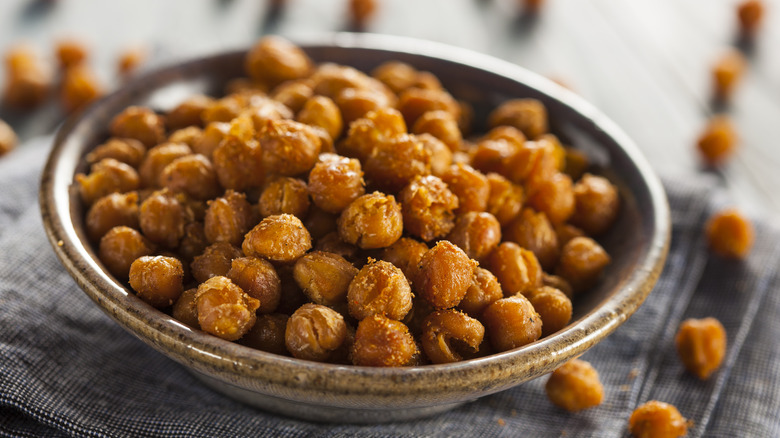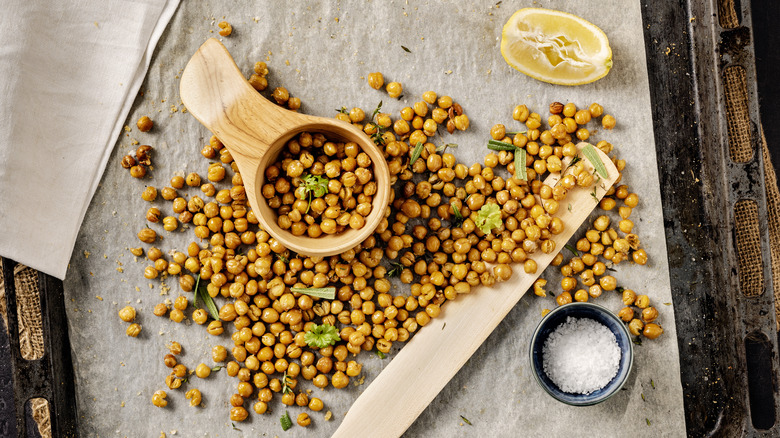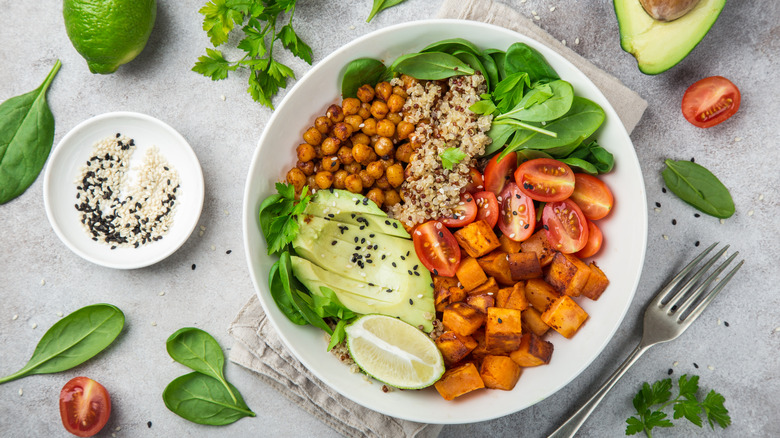How To Store Roasted Chickpeas So They Don't Get Soggy
Chickpeas (also known as garbanzo beans) have almost endless uses — they can be spun into hummus, stewed in soups and curries, or simply roasted until crisp, browned, and totally delicious. If you plan to roast large quantities of chickpeas as part of meal prep (or just as a snack), you may wonder how to store them. Unlike crunchy crackers or potato chips, these legumes can easily go from crisp to soft and soggy, due to leftover moisture content.
The fridge may seem like an obvious choice, but it's actually one of the worst places to store roasted chickpeas. For one, chickpeas need a certain amount of air circulation in order to stay crisp, which may not be possible in the dry, still air of the fridge. Secondly, colder temperatures can turn them chewy and unpleasant. You would have to re-roast the chickpeas to restore some of their appealing texture, and who has time for that?
Instead, store roasted chickpeas at room temperature in an unsealed container (but covered by a paper towel or dish towel). This will allow air to circulate and any remaining moisture to evaporate from the garbanzos, preventing sogginess. You can also use a glass jar, so long as you leave the lid cracked open. The chickpeas' optimal texture should last up to five days. Of course, the sooner you use your fried chickpeas as a crouton swap or as part of a snack mix, the better.
Your chickpea cooking method can also affect texture
Another way to get your chickpeas nice and crispy (and keep them that way) is to cook them wisely. The simplest way to roast chickpeas is to season them and toss them on a tray before putting them in the oven. However, chickpeas have a thin skin on the outside that can trap moisture during cooking, limiting how crispy they can get. This isn't to say you need to skin chickpeas in order to roast them, but it can certainly improve their final texture. Even better, you can use a shortcut method to get similar results with less meticulous work.
First, do an initial round of roasting without any seasonings, then remove the skins by rolling the chickpeas between dish towels. This will loosen most of the skins, but you will need to pick out the skins with your fingers. Be sure to thoroughly dry the chickpeas before returning them to the oven for a second roasting session. At this time, you can add oils and seasonings, but you can also wait until after roasting is complete. Tossing them in seasonings and just a little oil after the fact can help to reduce oil absorption, which will boost crispness in turn. Either way, allow the roasted chickpeas to cool and "set" into a firmer, crisper texture, then enjoy!
Delicious ways to use crispy chickpeas
Perfectly roasted chickpeas are so versatile that you won't have a hard time using up your stash. You can certainly eat them on their own, similar to how you might enjoy a bowl of popcorn, but with a tasty protein boost. They also make a fantastic crunchy addition to soups and salads. You can either scatter them on top of a creamy soup or simple salad as a garnish, or mix them into the other ingredients.
Try roasting chickpeas in a seasoning blend of thyme, oregano, and rosemary for a yummy addition to your favorite Greek quinoa salad. You can even roast them with a bit of lemon zest and mint to bring extra freshness to a three-bean salad recipe. Plus, you get the textural contrast of crunchy chickpeas and creamy beans.
Perhaps the most exciting and unconventional idea is to crush up roasted chickpeas into a breadcrumb substitute. You might want to roast them for longer than usual or let them dry out for a few days to ensure the crunchiest result. Just like that, you can use chickpeas seasoned to your liking to add a flavorful and crunchy breading to mac and cheese bites, or as a binding agent in a vegan sriracha meatball recipe. The possibilities are truly endless, so happy roasting!



